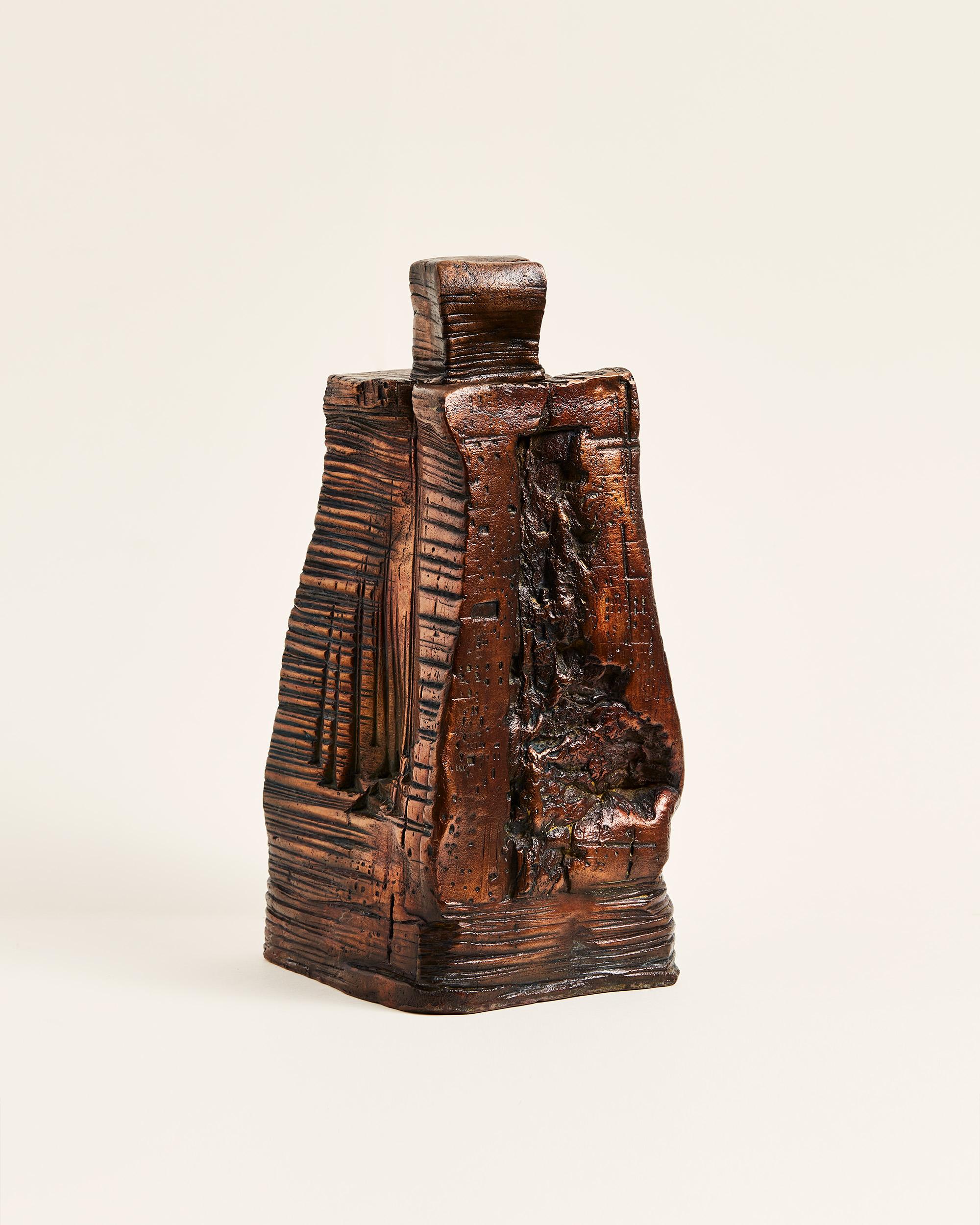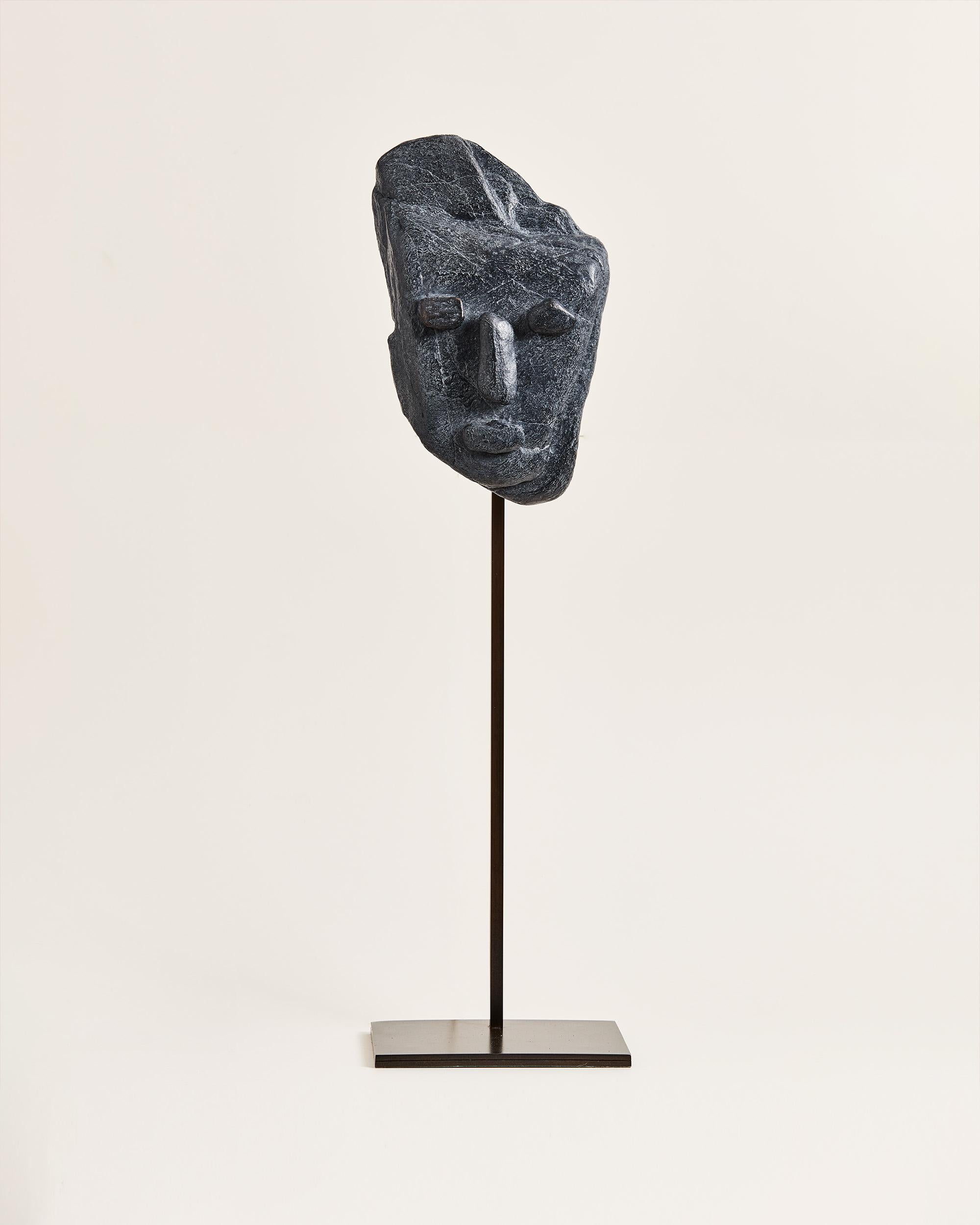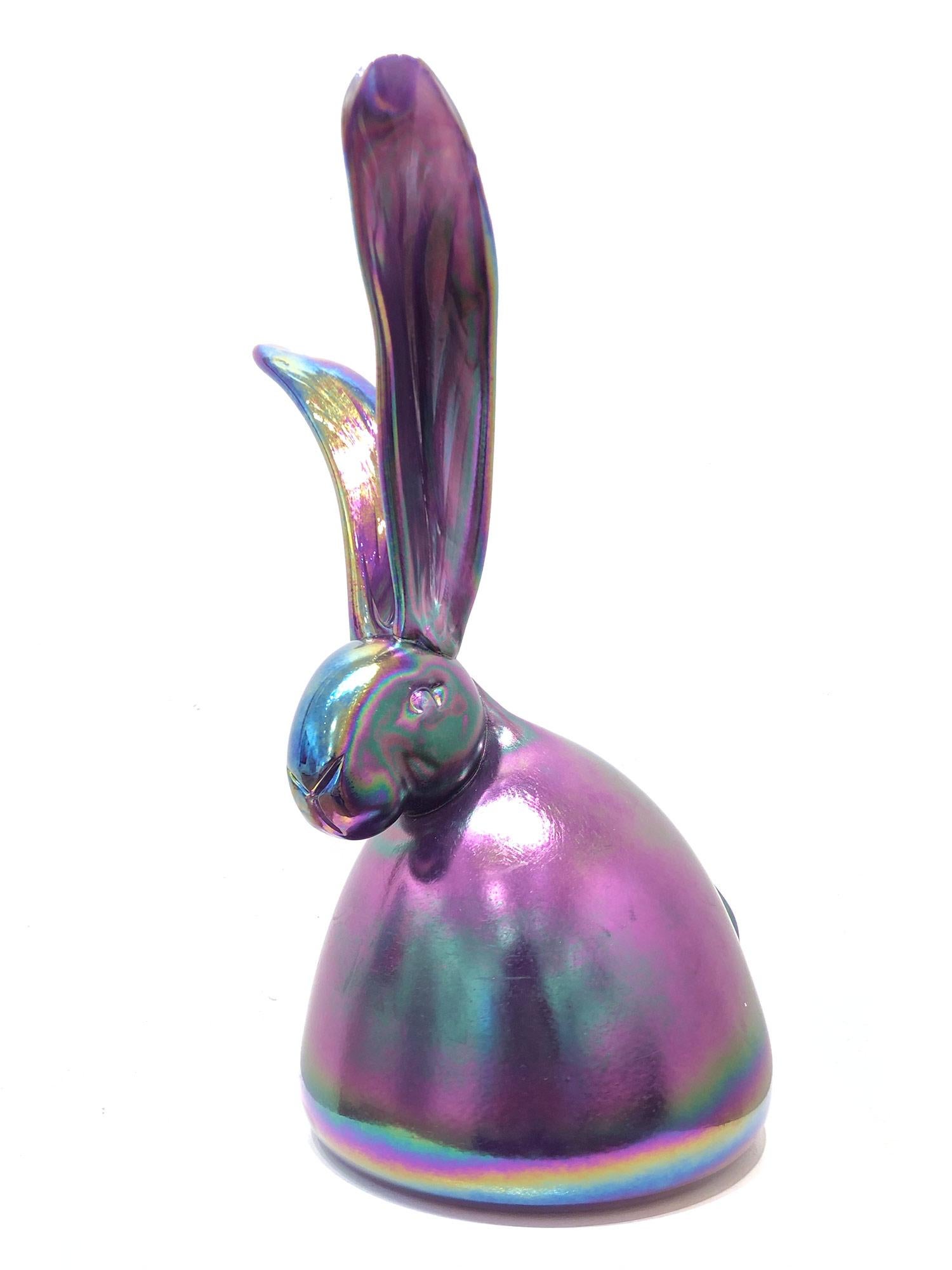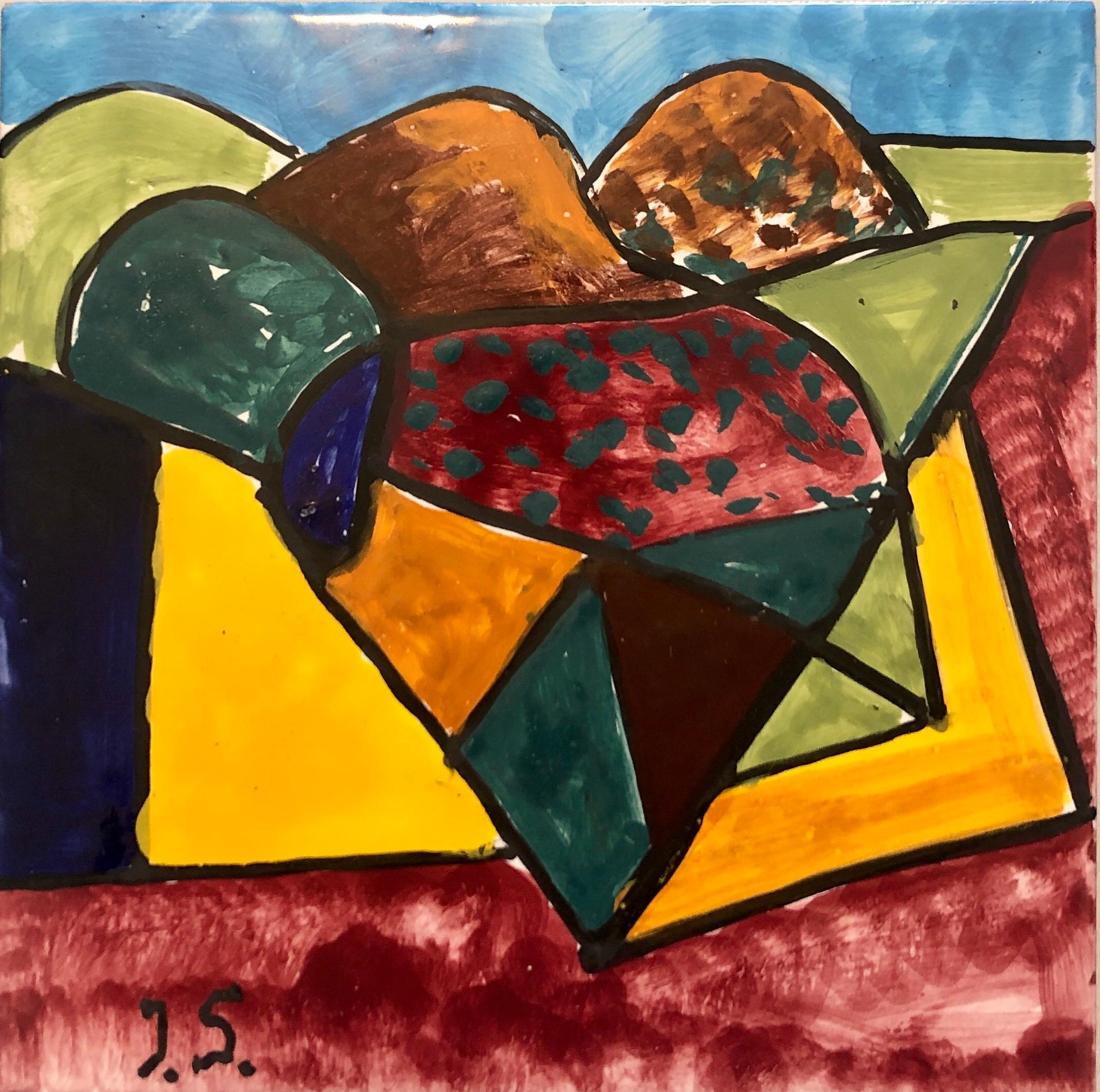Items Similar to Abstract Sculpture 'Ten Fathoms' (Swimming Fish) Bronze with Glass Unique Piece
Want more images or videos?
Request additional images or videos from the seller
1 of 7
Margaret Peggy ReventlowAbstract Sculpture 'Ten Fathoms' (Swimming Fish) Bronze with Glass Unique Piece
About the Item
Margaret Reventlow, American born London, 1915 - 2014, "Ten Fathoms Deep", (swimming fish) bronze with green and red slag glass, unsigned, with artist name, title, etc on a label on its swivel base.
Provenance: From the Estate of Countess Margaret Peggy Reventlow, Philanthropist and Artist, Direct Descendent of John Jacob Astor, then to the Oliver Wolcott Library. Reventlow's first exhibition was at the Palm Beach Gallery and she went on to shows in New York, London, Connecticut and Nantucket.
MARGARET PEGGY REVENTLOW (Margaret Astor Drayton)
American, 1915-2014
Peggy was born in London, England on December 20th, 1915. Her father, William Astor Drayton, was a great grandson of John Jacob Astor. In 1942, Peggy became Countess Margaret Reventlow when she married Danish Count Court Haugwitz-Hardenberg Reventlow.
Rentlow studied at Le Cours Maintnon in Paris and at Le College Feminin de Bouffemont. She studied sculpture with Oliver Barret and Felix de Weldon. She attended the Art Students League for six years, studying with Leo Manso and Bruce Dorfman. The resulting abstract paintings are rich and colorful, done in both acrylics and oils. “My paintings are all about movement and color and composition,” she said. “You have to work that way with abstract art.
Reventlow’s first solo New York exhibition took place at Hammer Galleries in 1961 and she exhibited there until 1968. In 1964 she had a solo exhibition at Tiffany and Co. Her work has been presented at the Palm Beach Galleries and at The Alwin Gallery in London as well as in Litchfield, Connecticut; Nantucket; Norfolk, Connecticut and elsewhere.
Her sculptures and paintings reflect her lifelong love of the outdoors and sports. Writing in Arts Magazine, critic William D. Allen remarked on the vibrant character of her work which he compared to that of the noted German Expressionist sculptors Ernst Barlach and Wilhelm Lehmbruck. Countess Reventlow was represented in New York by Viridian Artists.
- Creator:Margaret Peggy Reventlow (1915 - 2014, American)
- Dimensions:Height: 18 in (45.72 cm)Width: 15 in (38.1 cm)Depth: 14 in (35.56 cm)
- Medium:
- Movement & Style:
- Period:
- Condition:slag glass with natural defects and inclusions, bronze and glass are good.
- Gallery Location:Surfside, FL
- Reference Number:1stDibs: LU38212162112
About the Seller
4.9
Platinum Seller
These expertly vetted sellers are 1stDibs' most experienced sellers and are rated highest by our customers.
Established in 1995
1stDibs seller since 2014
1,548 sales on 1stDibs
Typical response time: 1 hour
- ShippingRetrieving quote...Ships From: Surfside, FL
- Return PolicyA return for this item may be initiated within 3 days of delivery.
More From This SellerView All
- Abstract Painted Ceramic Tile Pop Art Painting Italian Neo Figurative PaintingBy Italo ScangaLocated in Surfside, FLThis painted ceramic tile by Italo Scanga, epitomizes the characteristics of his oeuvre. Polychrome and vibrant art from the Memphis Milano era. This is signed with his initials. This is reminiscent of the mid century work of Jean Lurcat and Jean Picart le Doux. Italo Scanga (June 6, 1932 - July 7, 2001), an Italian-born American artist, was known for his sculptures, prints and, paintings, mostly created from found objects. In his youth in Calabria, Italy he worked as a cabinetmaker's apprentice and studies sculpture with a man who carved statues of saints. Italo Scanga was an innovative neo Dada, neo-Expressionist, and neo-Cubist multimedia artist who made assemblage, collage, sculptures of ordinary objects and created prints, glass, and ceramic works. Modern Italian abstract geometric folk art. Scanga's materials included natural objects like branches and seashells, as well as kitsch figurines, castoff musical instruments and decorative trinkets salvaged from flea markets and thrift shops. He combined these ingredients into free-standing assemblages, which he then painted. Although visually ebullient, the results sometimes referred to gruesome episodes from Greek mythology or the lives and deaths of martyred saints. He considered his artistic influences to be sweepingly pan-cultural, from African sculpture to Giorgio de Chirico. He often collaborated with the sculptor Dale Chihuly, who was a close friend. Constructed of wood and glass, found objects or fabric, his ensembles reflect a trio of activities—working, eating, and praying. These activities dominate the lives of those who live close to the land, but they are also activities that are idealized by many who contemplate, romantically, a simpler, bucolic life. Italo graduated from Michigan State University where he befriended fellow artists Richard Merkin and David Pease. He studied under Lindsey Decker who introduces him to welding and sculpture after his initial interest in photography. Also studies with Charles Pollock, the brother of Abstract Expressionist Jackson Pollock. His first teaching job was at University of Wisconsin (through 1964). where he met Harvey Littleton, a fellow instructor. He later moves to Providence, Rhode Island,I to teach at Rhode Island School of Design (RISD). Is colleagues with artists Richard Merkin and Hardu Keck. Starts a correspondence with HC Westermann. Spends summers teaching at Brown University; colleague of Hugh Townley. Moves to State College, PA, and teaches at Pennsylvania State University for one year. Meets artists Juris Ubans, Harry Anderson, Richard Frankel, and Richard Calabro, who remain friends throughout his career. 1967: David Pease helps him get a tenure track position at Tyler School of Art in Philadelphia, PA, . Artists he works closely with include Ernest Silva, Lee Jaffe, Donald Gill, and William Schwedler. Meets graduate student Dale Chihuly while lecturing at RISD and develops a lifelong friendship. 1969: One person exhibition, Baylor Art Gallery, Baylor University, Waco, TX. Works very closely with students Larry Becker and Heidi Nivling (who later run a gallery in Philadelphia, PA), and Harry Anderson. Welcomes many artists into his home including Donald Judd, Dan Flavin, Bruce Nauman (a former student), Vito Acconci, Ree Morton and Rafael Ferrer. 1973: "Saints Glass" at 112 Greene Street Gallery, NYC. Installation at the Institute of Contemporary Art at University of Pennsylvania, Philadelphia, PA. Meets Gordon Matta Clark and contributes to an artist cookbook. Goes to Pilchuck Glass School, Stanwood, WA, founded by Dale Chihuly, as a visiting artist. He continues to work there annually through 2001. Works over the years with Pilchuck artists Richard Royal, Seaver Leslie, Jamie Carpenter, Joey Kirkpatrick, Flora Mace, Robbie Miller, Billy Morris, Buster Simpson, Toots Zynsky, Howard Ben Tre...Category
1980s Neo-Expressionist Abstract Sculptures
MaterialsEnamel
- Abstract Painted Ceramic Tile Pop Art Painting Italian Neo Figurative PaintingBy Italo ScangaLocated in Surfside, FLThis painted ceramic tile by Italo Scanga, epitomizes the characteristics of his oeuvre. Polychrome and vibrant art from the Memphis Milano era. This is signed with his initials. This is reminiscent of the mid century work of Jean Lurcat and Jean Picart le Doux. Italo Scanga (June 6, 1932 - July 7, 2001), an Italian-born American artist, was known for his sculptures, prints and, paintings, mostly created from found objects. In his youth in Calabria, Italy he worked as a cabinetmaker's apprentice and studies sculpture with a man who carved statues of saints. Italo Scanga was an innovative neo Dada, neo-Expressionist, and neo-Cubist multimedia artist who made assemblage, collage, sculptures of ordinary objects and created prints, glass, and ceramic works. Modern Italian abstract geometric folk art. Scanga's materials included natural objects like branches and seashells, as well as kitsch figurines, castoff musical instruments and decorative trinkets salvaged from flea markets and thrift shops. He combined these ingredients into free-standing assemblages, which he then painted. Although visually ebullient, the results sometimes referred to gruesome episodes from Greek mythology or the lives and deaths of martyred saints. He considered his artistic influences to be sweepingly pan-cultural, from African sculpture to Giorgio de Chirico. He often collaborated with the sculptor Dale Chihuly, who was a close friend. Constructed of wood and glass, found objects or fabric, his ensembles reflect a trio of activities—working, eating, and praying. These activities dominate the lives of those who live close to the land, but they are also activities that are idealized by many who contemplate, romantically, a simpler, bucolic life. Italo graduated from Michigan State University where he befriended fellow artists Richard Merkin and David Pease. He studied under Lindsey Decker who introduces him to welding and sculpture after his initial interest in photography. Also studies with Charles Pollock, the brother of Abstract Expressionist Jackson Pollock. His first teaching job was at University of Wisconsin (through 1964). where he met Harvey Littleton, a fellow instructor. He later moves to Providence, Rhode Island,I to teach at Rhode Island School of Design (RISD). Is colleagues with artists Richard Merkin and Hardu Keck. Starts a correspondence with HC Westermann. Spends summers teaching at Brown University; colleague of Hugh Townley. Moves to State College, PA, and teaches at Pennsylvania State University for one year. Meets artists Juris Ubans, Harry Anderson, Richard Frankel, and Richard Calabro, who remain friends throughout his career. 1967: David Pease helps him get a tenure track position at Tyler School of Art in Philadelphia, PA, . Artists he works closely with include Ernest Silva, Lee Jaffe, Donald Gill, and William Schwedler. Meets graduate student Dale Chihuly while lecturing at RISD and develops a lifelong friendship. 1969: One person exhibition, Baylor Art Gallery, Baylor University, Waco, TX. Works very closely with students Larry Becker and Heidi Nivling (who later run a gallery in Philadelphia, PA), and Harry Anderson. Welcomes many artists into his home including Donald Judd, Dan Flavin, Bruce Nauman (a former student), Vito Acconci, Ree Morton and Rafael Ferrer. 1973: "Saints Glass" at 112 Greene Street Gallery, NYC. Installation at the Institute of Contemporary Art at University of Pennsylvania, Philadelphia, PA. Meets Gordon Matta Clark and contributes to an artist cookbook. Goes to Pilchuck Glass School, Stanwood, WA, founded by Dale Chihuly, as a visiting artist. He continues to work there annually through 2001. Works over the years with Pilchuck artists Richard Royal, Seaver Leslie, Jamie Carpenter, Joey Kirkpatrick, Flora Mace, Robbie Miller, Billy Morris, Buster Simpson, Toots Zynsky, Howard Ben Tre...Category
1980s Neo-Expressionist Abstract Sculptures
MaterialsEnamel
- Early Murano Glass Free Form Abstract Blown, Cut, Glass Sculpture in Bronze VaseLocated in Surfside, FLThis piece appears unsigned and unmarked. It came from an important estate in the Palm Beach area. It is an abstract flame or torch in a bronze vase. Venetian glass (Italian: vetro ...Category
1940s Abstract Abstract Sculptures
MaterialsBronze
- Mexican Art Abstract Brutalist Biomorphic Bronze Sculpture Mathias GoeritzBy Mathias GoeritzLocated in Surfside, FLMathias Goeritz (German Mexican, 1915-1990) Bronze sculpture Signed and numbered Dimensions: (approximate) Height: 10 inches, Width: 4 inches, Depth: 2 inches. This is a cast bronze sculpture in an amorphous figure shape, quite heavy. Reminiscent of the biomorphic sculpture of Hans Jean Arp. This came from an estate and bears his signature It is not dated. there is no accompanying documentation. it is priced accordingly. Werner Mathias Goeritz Brunner (Danzig, Germany, April 4th, 1915/ now Gdansk, Poland – Mexico City, Mexico; August 4th, 1990). Mathias Goeritz has had several gallery and museum exhibitions, including at the Museo Nacional Centro de Arte Reina Sofía and at the Museo Experimental El Eco. Numerous works by the artist have been sold at auction, including 'MENSAJE' sold at Sotheby's New York 'Latin American Modern Art' in 2015 for $466,000. There have been Several articles about Mathias Goeritz, including 'LACMA remaps Latin America' written by Suzanne Muchnic for the Los Angeles Times. Painter, sculptor and Mexican architect associated with the trend of constructive abstraction. He studied medicine at the University of Berlin, but this only lasted a year. The concerns of the young student were aesthetic in nature so he he studied figurative drawing at the Berlin Charlottenburg School of Art. Some of his friends and colleagues were the sculptor Ernst Barlach, painter George Grosz and draughtsman Kaethe Kollwitz. Goeritz studied philosophy and history of art, discipline in which earned a doctorate. He travelled in France, Switzerland, Czechoslovakia, Poland, Austria and Italy, among other countries. It is known that he left Germany to live in Tetuan, Morocco in 1941 and then Granada, Spain in 1945. In 1946 he had a large exhibition in the Sala Clan in Madrid under the pseudonym "Mago". Two years later, living in Santilla del Mar, Spain he was a founder of the Escuela de Altamira. The following year he married Marianne Gast, writer and his companion for more than fifteen years. In Spain followed his artistic work by important artists of the avant-garde. Of Jewish descent, he found refuge from the Second World War in Mexico where in 1949 he was invited by Ignacio Diaz Morales to be a part of the faculty of the School of Architecture at the Universidad de Jalisco. In 1953 he wrote the "Manifiesto de la Arquitectura Emocional" (The Emotional Architecture Manifesto), where he points out that only achieving true emotions from architecture can it then be considered an art form. In Mexico he entered controversy with the artistic stablishment of that country; in an open letter, Diego Rivera and David Alfaro Siqueiros described him as "an impostor without the most insignificant talent and preparation" to be an artist. Despite this, in 1957 he was elected director of visual design of the National School of architecture This same year he founded the Museo del Eco in Mexico City. In 1961 Goeritz participated at the Galería Antonio Souza in a group exhibition, Los hartos, for which he published another manifesto. Other participants included Jose Luis Cuevas and Pedro Friedeberg, with whom he was instrumental in establishing abstraction and other modern trends in Mexico.His work is included in the Gelman Collection of modern and contemporary Mexican art based in Cuernavaca, Mexico. Established by Jacques and Natasha Gelman in 1943 as a private collection. it includes many iconic works by major Mexican Modernists including Frida Kahlo, Diego Rivera, David Alfaro Siqueiros, Leonora Carrington, Rufino Tamayo and Francisco Toledo, Lola Alvarez...Category
20th Century Modern Abstract Sculptures
MaterialsBronze
- Israeli Bronze Sculpture Lovers Embrace Abstract Modernist Ein Hod IsraelBy Gedalia Ben ZviLocated in Surfside, FLBronze sculpture signed in Hebrew and numbered from small edition of 6 BIOGRAPHY "I was born in Czechoslovakia in the year 1925, of traditional parents. I spent my youth partly in a little town on the Moravian border, and to a greater part in Bratislava, the capital of Slovakia. Having been attracted by the arts from early childhood on, I studied functional art at a school in Bratislava, as long as this was still possible under the Nuremberg Laws which, at that time, were also in force in Slovakia. In 1942 I was taken to a concentration camp in Poland and at the beginning of 1945 I succeeded in escaping together with a friend of mine. Until our liberation by the Russians we were hiding in the forests of Northern Poland. At the end of the War I found myself wandering about Europe, together with thousands of survivors from the Holocaust, until, in 1948 I came to Israel via the Camps of Cyprus. From 1954 onwards I have been a permanent resident of the Artists Village at Ein-Hod, together with my family. In the course of that time I studied and worked in most of the creative techniques of the arts. During various periods of my life at Ein-Hod I taught painting and handicraft at different schools. In 1965 I gave up teaching and have since devoted myself exclusively to pure art." Gedalia Ben Zvi. Exhibitions 1962-1963 Design Exhibition, Tel Aviv 1964 Middle East Fair, Tel Aviv 1965 Ceramic Mural for school in Kiryat Gat a the Housing Exhibition in Tel Aviv 1966 Israel Fair and Exhibition, Paris One man show, Ein Hod International Symposium on “Ceramics in Architecture” Tel Aviv Ceramic Museum Museum or Modern Arts, Heavy Museum of Acre 1968 Painters Israeliens dans I’Art de Gobelins, Jerusalem Ein Hod Artists Village - Tenths Year Anniversary Exhibition 1963, Artists: Zvi Aldouby, Marcel Janco, Rudi Lehmann, Moshe Mokady, Aviva Margalit Mambush, Yohanan Simon, Dov Feigin, Ovadia Alkara, Mark Tochilkin...Category
Mid-20th Century Modern Figurative Sculptures
MaterialsBronze
- Rachid Khimoune French Algerian Arab Art Brut Bronze Sculpture Abstract FigureLocated in Surfside, FLRachid Khimoune (Algerian, b. 1953) Les enfants du monde bronze. signed and numbered artist's edition of 4 foundry mark - L. Cappe 7.5 x 4.63 x 2.38 Overall: 8.25 x 4.63 x 2.38 RACHID KHIMOUNE, Algerian-French artist and sculptor. Born in 1953 in Decazeville, France. Lives and works in Paris, France. Rachid Khimoune graduated from the School of Art of Paris in 1974; he initially started to work with painting before choosing sculpture. In 1980 he won the first prize of the Foundation of France. He works in an Art Brut, Naif art style similar to Jean Dubuffet and Enrico Baj. Being the recipient of numerous prestigious awards and an extensive oeuvre, Rachid Khimoune has been exhibiting since 1975 and his work can be found in several museums, and public and private collections. The artist behind the project Rachid Khimoune, has been responsible for a number of major, successful public art installations in France. Most famously, the installation close to the Bibliothèque Nationale (National Library) ‘Les Enfants du Monde’ (The Children of the World). Rachid’s newer works are masks and totems cast in bronze: poetic images forged in a furnace. Rachid uses discarded objects and disused parts of machines, to create new human and animal forms. Here his interest in metal-working and Arab art-African art coincides with the assemblage of found objects; one mask is a collage constituted by a large model of the Eiffel Tower stuck into the end of a trumpet. Another has a jerry-can for a face, and the golden patina and surface-working of the bronze does not dispel the idea which this image creates: of a human mouth drinking oil. Born in France to parents from Algeria, Khimoune embraces the role of the artist as a global citizen, using art as a universal language. Select Awards Lauréat du Prix de la Fondation de France (1980) Chevalier des Arts et Lettres (2002) Grande Médaille de la Ville de Paris (2004) Chevalier de la Légion d’Honneur (2007) EXHIBITIONS SOLO EXHIBITIONS 2017 Ar[T]senal, Dreux, France 2016 Musée Tavet Delacour, Pontoise, France 2015 Parvis de l’Hotel de ville, Paris 2015 Beirut Art Fair, Beyrouth, Liban 2015 Galerie Francoise Souchaud, Lyon 2014 Musée Rabelais, Seuilly, France 2013 Galerie Vallois...Category
20th Century Expressionist Abstract Sculptures
MaterialsBronze
You May Also Like
- Boite empreinte - Contemporary Bronze abstract SculptureLocated in PARIS, FRSculpture en bronze de l'artiste Pascale Hamelin. Pascale Hamelin est une sculptrice française. Ses visages et ses formes racontent le souvenir du pas...Category
2010s Neo-Expressionist Abstract Sculptures
MaterialsBronze
- Bronze Grand Bénatien - Contemporary Bronze Portrait Sculpture, 2015Located in PARIS, FRSculpture en bronze sur socle par l'artiste Pascale Hamelin. Pascale Hamelin est une sculptrice française. Ses visages et ses formes racontent le souv...Category
21st Century and Contemporary Neo-Expressionist Abstract Sculptures
MaterialsBronze
- Boite empreinte - Contemporary Bronze abstract Sculpture, 2015Located in PARIS, FRSculpture en bronze de l'artiste Pascale Hamelin. Pascale Hamelin est une sculptrice française. Ses visages et ses formes racontent le souvenir du pass...Category
2010s Neo-Expressionist Abstract Sculptures
MaterialsBronze
- "Zofia" Unique Glass Blown Bunny Sculpture in an Iridescent Purple ColorBy Hunt SlonemLocated in New York, NYEver expansive in his Animalia quest, renowned artist Hunt Slonem continues to boldly pursue his unique vision. Divining new forms for his aesthetic muses in hand-blown glass, neon and other illuminating raw materials, the artist’s impressive career spanning almost five decades enters a new phase. Bunnies. This piece depicts a gestural figure of purple iridescent bunny. This is a one of a kind piece. Illuminating and awe inspiring, Hunts new Glass Blown Sculptures...Category
2010s Neo-Expressionist Figurative Sculptures
MaterialsGlass
- "Il narratore" by Enzio Wenk, 2020 - Pink Wooden Sculpture, Neo-ExpressionismBy Enzio WenkLocated in Bresso, ITTranslated title: "The narrator". Enamel, wood, charcoal and gauze.Category
2010s Neo-Expressionist Abstract Sculptures
MaterialsEnamel
- Masque origine - Contemporary Ceramic portrait sculptureLocated in PARIS, FRSculpture murale par l'artiste Pascale Hamelin. Pascale Hamelin est une sculptrice française. Ses visages et ses formes racontent le souvenir du passé,...Category
2010s Neo-Expressionist Abstract Sculptures
MaterialsCeramic
Recently Viewed
View AllMore Ways To Browse
Green Glass Sculpture
20th Century Abstract Bronze
Abstract Bronze Sculpture On Base
Red Art Glass Sculpture
Bronze Fish
Sculpture 1942
Sculpture For Outdoors
Abstract Danish Sculpture
Palm Sculptor
Glass Fish Sculpture
Glass Sculpture Colorful
Beach Nantucket
Danish Expressionist
Abstract Sculpture Unsigned
Fish Swimming
Bronze Sculpture Denmark
Abstract Fish Sculpture
Tiffany Co Red





